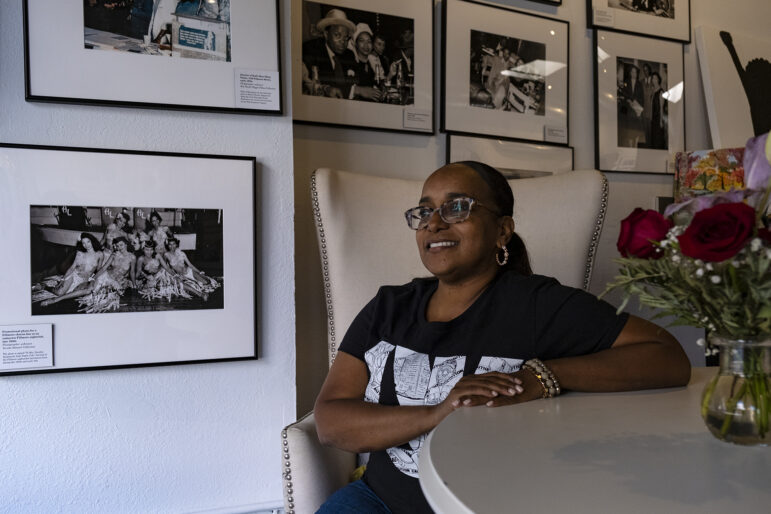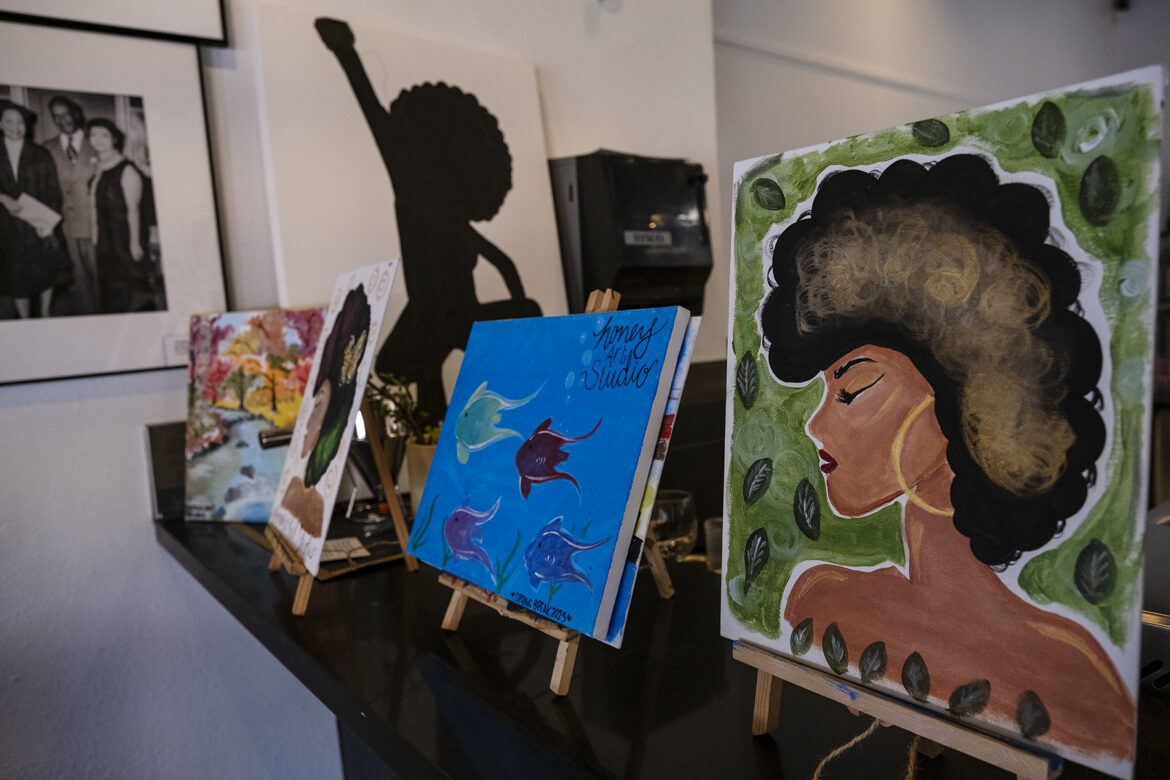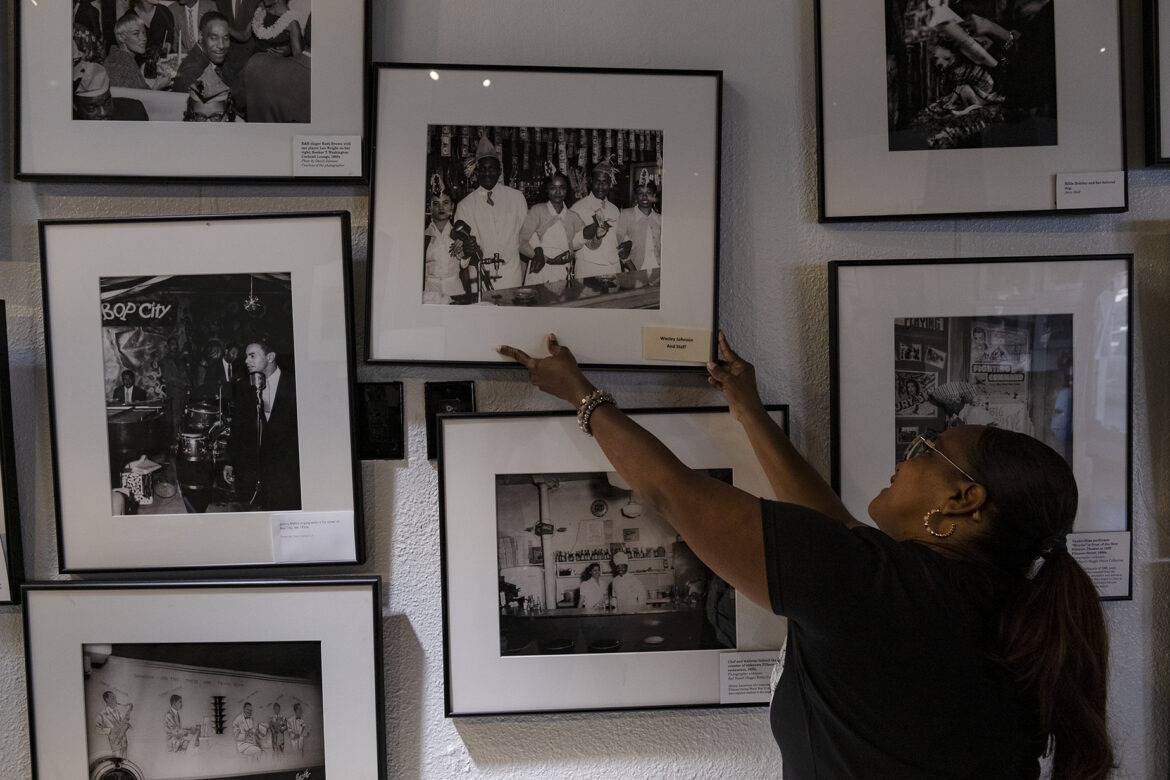This article is adapted from an episode of our podcast “Civic.” Click the audio player below to hear the full story.
After 2½ years of meetings, community discussions, historical deep dives and policy generation, a panel tasked with proposing how San Francisco might atone for decades of discrimination against Black residents is ready to ask the city to step up and support equity rhetoric with action.
San Francisco’s African American Reparations Advisory Committee is aiming to submit its final recommendations to the city on June 30, according to Brittni Chicuata, director of economic rights at the city’s Human Rights Commission. In the meantime, the city’s annual budget process is in full swing, which may affect funding and the timeline for whatever reparations policies the board decides to pursue.
The recommendations are nonbinding, meaning the Board of Supervisors may choose to support any number of the policies, or none at all. It can also amend them.
“Where the rubber hits the road is what that Board of Supervisors does,” said the Rev. Amos Brown, president of the San Francisco NAACP branch and health subcommittee lead for the reparations committee. “The ball is in their court.”
The recommendations, released only in draft form, number more than 100 and tackle disparities in educational achievement for Black students, differences in the median life expectancy for Black San Franciscans and the overrepresentation of Black people experiencing homelessness and incarceration.
In a March meeting, supervisors voiced support for reparations, unanimously voting to accept the draft in a nonbinding resolution. Of the proposed policies, some could be enacted quickly, while others would require more time. In some cases, advocacy at the state and federal level is required.
Breed must propose a city budget in June. Tinisch Hollins, vice chair of the reparations committee, said the group has been discussing how to secure funding in this year’s budget.
“We’ve been actively having conversations as a committee, looking at the recommendations that are what’s been called low-hanging fruit, that the city could potentially move forward on in this budget cycle,” Hollins said in an April interview. She noted that the majority of city departments have equity plans that could offer starting points for improving accountability and addressing the needs of Black residents.
“Since you have an equity plan, you can then reallocate or reconfigure your budget so that this becomes a priority for what you need to do,” she said.
An Office of Reparations
After its plan is submitted, the committee — which is authorized to operate until January 2024 — will continue meeting to discuss how the city can follow through on reparations.
Some community leaders are eager to ensure this work continues. Supervisor Shamann Walton, who represents Bayview-Hunters Point, Potrero Hill and Visitacion Valley, introduced legislation in March requesting $50 million to establish an Office of Reparations that would help implement policies and find people eligible for programs.
Walton is trying to get the proposal on the agenda at the board’s Budget and Appropriations Committee, which is the first step before a budget request would go to the full board for a vote.
“If we get the supplemental heard and passed, obviously that will go into this budget cycle,” he said. “And then my hope is, of course, to be able to extend and get resources into the next budget.”
However, Breed indicated in late April that she had “no plans at this time” to back the proposal.
To qualify for reparations, individuals must:
1. Have identified as Black or African American on public documents for at least 10 years
2. Be 18 years or older
3. Meet at least two of the following criteria:
a. Have been born in San Francisco between 1940 and 1996, and have proof of residency in San Francisco for at least 13 years
b. Have migrated to San Francisco between 1940 and 1996, and have proof of residency in San Francisco for at least 13 years
c. Have been incarcerated or were the direct descendant of someone incarcerated as part of what the committee describes as “the failed war on drugs”
d. Have a record of attendance in San Francisco public schools during the time of the consent decree to complete desegregation within the school system
e. Be a descendant of someone enslaved in chattel slavery in the United States before 1865
f. Have been displaced or the direct descendant of someone displaced from San Francisco by urban renewal between 1954 and 1973
g. Be a Certificate of Preference holder, or the direct descendant of one
h. Be a member of a historically marginalized group that experienced lending discrimination in San Francisco between 1937 and 1968, or experienced lending discrimination in formerly redlined San Francisco communities between 1968 and 2008
It is unclear how many people will qualify for reparations given the variety of criteria that the plan outlines.
In response to recent questions about the mayor’s thoughts on the reparations plan broadly and how implementation of any policies would work without an Office of Reparations, her office wrote in an email: “The policies presented in the plan will be considered once they are final.” Instead of commenting on policy proposals, the email pointed to other programs that address racial inequity, such as the Dream Keeper Initiative and guaranteed income programs. The Dream Keeper Initiative provides down payment loans for first-time Black home buyers. The reparations plan suggests turning these loans into grants for those who qualify, among other housing-specific policy changes.
Walton is still trying to gain support from Breed and Board of Supervisors colleagues. If he fails to win over the mayor, he will need a veto-proof majority of eight supervisors on his side.
Breed’s lack of support for the office was disappointing to at least one committee member the day after it was announced.
“I haven’t talked to any other committee members, but I imagine they’re all discouraged right now,” said James Lance Taylor, a political science professor at the University of San Francisco, who also sits on the reparations committee.
However, in the April interview, Hollins expressed what she called a “cautious optimism” that reparations work would move forward.
“If we do our work at helping to identify what’s immediate need, what the opportunity is, and then we collaborate with both the Mayor’s Office and the Board of Supervisors, we’ll be able to start moving things downstream, even before we have an Office of Reparations, or whatever entity is going to be in place,” she said.
‘The Second Oldest Idea in Black Politics’
The committee’s draft plan spurred a wave of headlines across the country when it was made public. A proposal to give each eligible African American in the city a one-time payment of $5 million led to criticisms regarding cost, especially as the city faces a $780 million budget deficit in the next two years.
Support for reparations is skewed heavily by race. A 2021 Pew Research Center study shows that 77% of Black Americans support reparations, compared with 18% of whites.
Much like the California State Reparations Task Force, which recently voted to approve policy proposals for the state Legislature’s consideration, the San Francisco committee is running into the question: Why are reparations being considered in a state where slavery was never legal?
For his part, Taylor said the concept of reparations “is the second oldest idea in Black politics, the first one being abolition.”
Hollins said California shared responsibility with the rest of the country for enforcing the Fugitive Slave Act, a law that compelled people in free states to capture those who had fled and send them back to enslavement out of state. California also at various times banned Black people from voting and failed to provide them with other legal rights and protections.
“California may have never had slavery as they put it, but the badges of slavery were here,” she said, adding that California “certainly supported all of the racist policies that excluded black people specifically, and that harm has had real consequences.”
Today, the lifespan of Black San Franciscans is 11 years shorter than the citywide average. Black households in San Francisco have a staggering low median income, $34,000 per year in 2019, compared with a citywide median of $112,000.
Urban Renewal
But slavery isn’t the only reason Black San Franciscans are pushing for reparations.
“Where people often think about slavery as the qualifying act that brings on the need for reparations, we know we have this very long history of deep housing discrimination and instability,” said Rachel Brahinsky, a professor of politics and urban studies at the University of San Francisco.
Starting in the 1930s, the federal government began denying Black borrowers loans based on a discriminatory housing practice known as redlining, in which certain areas — especially those with high concentrations of people of color — were deemed “high risk” for lending. Though redlining was a federal program, municipal officers as well as local bank officials, real estate agents and appraisers helped those creating the maps and designating risk. The maps informed local lending decisions in both the private and public sectors, which is how redlining contributed to racial disparities in homeownership, residential segregation and disinvestment from communities of color.
Brahinsky said racially restrictive covenants, which were rules written into property deeds that barred Black people from owning or renting these properties, as well as a practice in which real estate agents would encourage African Americans to move to certain parts of town when looking for homes, preserved segregation.

Yesica Prado / San Francisco Public Press
For Ericka Scott, housing the “Harlem of the West” exhibit at her art gallery is an honor. Looking at the photos of Black life, the strong business community and thriving music scene in the ‘40s, ‘50s and ‘60s gives her hope for the Fillmore’s future. Many famous musicians played at clubs across the Fillmore, including Ella Fitzgerald, Louis Armstrong, Miles Davis, Eartha Kitt and Billie Holiday. The clubs were also gathering sites for other influential members of the community.These policies contributed in part to the segregation of Black people into two main neighborhoods in San Francisco: the Fillmore and Bayview-Hunters Point. Both neighborhoods were later subject to another discriminatory housing program known as urban renewal. Under this federal program, which purported to remove “blight” from cities, the government seized land using eminent domain, and cities razed buildings to make way for new construction.
“The way that blight was defined, it was about peeling paint, it was about infrastructural problems,” Brahinsky said. “But it was also about people and was also about race very much.” She said that up to 20,000 people were displaced by the program in San Francisco.
“It drastically changed the community,” said Ericka Scott, a Black businesswoman who was raised in the Western Addition and now owns Honey Art Studio. “What was once said, originally, to remodel, redevelop, fix up the community, was really code for demolish the community, get people out of here and get new people in.”
Today, San Francisco’s Black population is an estimated 5.7%, compared with 13.4% at its peak in 1970.
Before urban renewal, the Fillmore was a thriving cultural hub with numerous jazz clubs and Black-owned businesses, and was known as the Harlem of the West. Scott’s gallery gives visitors a taste of what that was like through a series of photos from “Harlem of the West,” a book of photos by Elizabeth Pepin Silva and Lewis Watts that chronicles the local jazz scene in its heyday.
Lily Robinson-Trezvant, 78, remembers hearing jazz music as she walked down the streets of the Fillmore during her childhood. Her family came to San Francisco in the wake of World War II. After living in military housing, her parents purchased a home.
“It was a beautiful two-story Victorian house. And it was perfect for our family,” she said. “They finally were living their dream. And just like they got it, they lost it.”
Robinson-Trezvant’s home was seized by the government, and her family moved to Plumas County near Reno, Nev. In compensation, they received “just nothing,” she said. “You couldn’t buy a house with what they gave us.” Her mother had a nervous breakdown. Eventually, the family returned to San Francisco, this time as renters, only to be displaced a second time when that home was torn down, she said.
In the years following demolitions, many plots of land remained vacant, said Lewis Watts, an archivist and co-author of “Harlem of the West.”
“For 20 or 30 years, the Fillmore almost looked like a ghost town. It would look like a war zone because there were a number of empty lots,” that remained undeveloped for years, he said.

Yesica Prado / San Francisco Public Press
Honey Art Studio offers classes and workshops for painting, dance, crafts, fashion and interior design to build opportunities and confidence in the Black community.Though it’s impossible to put a value on the trauma her family suffered, Robinson-Trezvant can point to the current value of her family’s first home. Unlike many buildings that were torn down, Robinson-Trezvant said her home was actually moved to the Mission District and she keeps tabs on it by checking real estate websites. The house is worth about $2.5 million today.
The Fillmore wasn’t the only African American community to be affected by redevelopment. Learning from what transpired further north, Black San Franciscans in Bayview-Hunters Point fought for redevelopment on their own terms, with some success. A group of Black women known as the Big Five secured $40 million in federal funding for new housing during redevelopment, but ultimately the neighborhood was hampered by a lack of investment in other areas, such as jobs, public transit and other factors like environmental racism.
[For a more in-depth exploration of how the Fillmore and Bayview-Hunters Point were affected by urban renewal, listen to the full “Civic” episode.]
Looking ahead
At the time of the interview, Robinson-Trezvant had not been following the reparations plan closely. However, she now has a copy of the draft plan, and said she wanted to read it through before forming an opinion on it. When asked if the city could repair past harms to the Black community, she said, “Anything is possible if you try and you care.”
Taylor, the political science professor, said he believed some kind of reparations would be approved, because these conversations are happening simultaneously across the country, and at the national level.
“We’ve mobilized hundreds of people in the city,” he said. “We’ve mobilized cities around America, where we’re inspiring people all over the planet.” Particularly children, who someday will be responsible for carrying on this work.
“We planted the seed for the next generation,” he added. “So even if we don’t win this battle, ultimately, if America can ever be right, we will win the war.”
Read the draft reparations plan.
The next African American Reparations Advisory Committee meeting is June 5 at 5:30 p.m.

